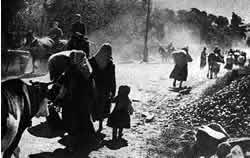Battle of Kars (1920)
| Battle of Kars | |||||||
|---|---|---|---|---|---|---|---|
| Part of Turkish-Armenian War | |||||||
 Armenian civilians fleeing Kars after its capture by Kazım Karabekir's forces. | |||||||
| |||||||
| Belligerents | |||||||
|
|
| ||||||
| Commanders and leaders | |||||||
|
|
| ||||||
| Strength | |||||||
| 8,000-10,000 men[1] | 18,700 men[1] | ||||||
| Casualties and losses | |||||||
|
150+ killed soldiers[1] 3,000+ (POW)[2] | 9 killed and 47 wounded soldiers[1] | ||||||
The Battle of Kars was the largest battle of the Turkish-Armenian War. The battle was fought between the Turkish Revolutionaries operating under the command of the newly formed Grand National Assembly of Turkey (TBMM) and the Democratic Republic of Armenia. After launching a massive assault on the city, the Turkish Army captured the city of Kars. The battle took place on October 30, 1920.
Background[]
This section needs expansion. You can help by . (June 2008) |
By September 28, General Kâzım Karabekir's forces had retaken Sarıkamış and the following day Kağızman.[3] They then moved towards Kars but this assault was delayed by Armenian resistance. Before the battle Karabekir attempted to set the Armenians on the wrong track by dispatching false messages about troop movements.[1] Karabekir's plan was to avoid a frontal attack on the city and instead surround it from the rear and cut off the railway and road to Alexandropol.[4] In the days leading up to the assault Turkish troops captured several strategic heights around Kars and placed the city at risk of encirclement. Although by October 29 the fortress was surrounded on three sides, the Armenian commander Daniel Bek-Pirumian assured the Armenian ministry of defense that the fortress could withstand the enemy.[4] On the evening of October 29, Colonel Hovhannes Mazmanian tried to retake the heights of Vezinkoy from the Turkish forces, but his men refused to follow him, after which Mazmanian committed suicide.[4] The Armenians abandoned many of their key positions without a fight and fled to the main fortress of Kars.[4]
The Fall of Kars[]
On the morning of October 30, the Turkish troops began their operation to surround and capture the fortress.[4] After successfully capturing the important height of Fort Lazarev, Turkish troops entered the city almost unopposed from the plain, causing panic among the city's civilians and the defending soldiers.[4] Chaos ensued as civilians and soldiers tried to flee the city, hardly putting up any resistance to the Turks.[4] At noon, seeing that the situation was hopeless, Colonel Vahan Ter-Arakelian, General Pirumian's chief of staff, came out of the citadel with a white flag to offer their surrender in exchange for the sparing of the civilian population and proper treatment of prisoners of war.[4] By the mid-afternoon of October 30, the last pockets of Armenian resistance had been defeated.[4]
Results[]
This section needs expansion. You can help by . (June 2008) |
Generals Pirumian, Araratov, and Ghazarian, Colonels Shaghubadian, Vekilian, Babajanov, and Ter-Arakelian, thirty-odd officers and about 3,000 soldiers, Acting Minister of Welfare Artashes Babalian, Archbishop Garegin Hovsepiants, provincial vice-governor Ruben Chalkhushian, mayor Hamzasp Norhatian and many civilians were taken prisoner.[2] Most of the junior officers and enlisted men who were captured were taken to Erzurum for confinement and forced labor, where many of them died during the winter.[4] Large amounts of military materiel, artillery, locomotives and other equipment were left behind by the Armenians.[4] Because the Turkish troops had not succeeded in completely surrounding the city, most of the Armenian battalions managed to escape, but the fall of Kars destroyed the fighting ability of the Armenian army.[4]
Turkish forces continued to advance and soon captured the city of Alexandropol (present-day Gyumri, Armenia) one week after the capture of Kars. On November 12, the Turks also captured the strategic village of , northeast of the ruins of the former Armenian capital of Ani and then planned to move towards Yerevan.[citation needed]
References[]
- ^ Jump up to: a b c d e Ömer Selvi, Turkish-Armenian relationship during the Turkish national independence struggle and the Gumru Agreement, Eskişehir Osmangazi University (Institute of Social science), June 2007, pg 108-110 (in Turkish)
- ^ Jump up to: a b Christopher J. Walker, Armenia: The Survival of a Nation, Croom Helm, 1980, p. 310.
- ^ Robert H. Hewsen. Armenia: A Historical Atlas, p. 237. ISBN 0-226-33228-4
- ^ Jump up to: a b c d e f g h i j k l Hovannisian, Richard G. (1996). The Republic of Armenia, Vol. IV: Between Crescent and Sickle, Partition and Sovietization. Berkeley: University of California Press. pp. 245–261. ISBN 0-520-08804-2.
- Conflicts in 1920
- Battles of the Turkish–Armenian War
- 1920 in Armenia
- History of Kars
- 1920 in the Ottoman Empire
- October 1920 events
